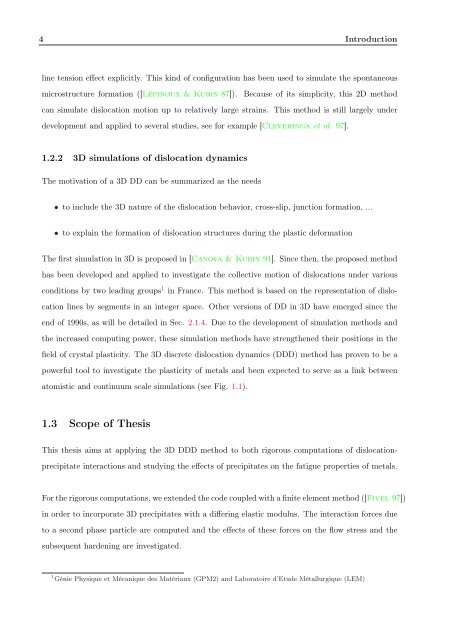3D DISCRETE DISLOCATION DYNAMICS APPLIED TO ... - NUMODIS
3D DISCRETE DISLOCATION DYNAMICS APPLIED TO ... - NUMODIS
3D DISCRETE DISLOCATION DYNAMICS APPLIED TO ... - NUMODIS
You also want an ePaper? Increase the reach of your titles
YUMPU automatically turns print PDFs into web optimized ePapers that Google loves.
4 Introduction<br />
line tension effect explicitly. This kind of configuration has been used to simulate the spontaneous<br />
microstructure formation ([Lépinoux & Kubin 87]). Because of its simplicity, this 2D method<br />
can simulate dislocation motion up to relatively large strains. This method is still largely under<br />
development and applied to several studies, see for example [Cleveringa et al. 97].<br />
1.2.2 <strong>3D</strong> simulations of dislocation dynamics<br />
The motivation of a <strong>3D</strong> DD can be summarized as the needs<br />
• to include the <strong>3D</strong> nature of the dislocation behavior, cross-slip, junction formation, ...<br />
• to explain the formation of dislocation structures during the plastic deformation<br />
The first simulation in <strong>3D</strong> is proposed in [Canova & Kubin 91]. Since then, the proposed method<br />
has been developed and applied to investigate the collective motion of dislocations under various<br />
conditions by two leading groups 1 in France. This method is based on the representation of dislo-<br />
cation lines by segments in an integer space. Other versions of DD in <strong>3D</strong> have emerged since the<br />
end of 1990s, as will be detailed in Sec. 2.1.4. Due to the development of simulation methods and<br />
the increased computing power, these simulation methods have strengthened their positions in the<br />
field of crystal plasticity. The <strong>3D</strong> discrete dislocation dynamics (DDD) method has proven to be a<br />
powerful tool to investigate the plasticity of metals and been expected to serve as a link between<br />
atomistic and continuum scale simulations (see Fig. 1.1).<br />
1.3 Scope of Thesis<br />
This thesis aims at applying the <strong>3D</strong> DDD method to both rigorous computations of dislocation-<br />
precipitate interactions and studying the effects of precipitates on the fatigue properties of metals.<br />
For the rigorous computations, we extended the code coupled with a finite element method ([Fivel 97])<br />
in order to incorporate <strong>3D</strong> precipitates with a differing elastic modulus. The interaction forces due<br />
to a second phase particle are computed and the effects of these forces on the flow stress and the<br />
subsequent hardening are investigated.<br />
1 Génie Physique et Mécanique des Matériaux (GPM2) and Laboratoire d’Etude Métallurgique (LEM)


